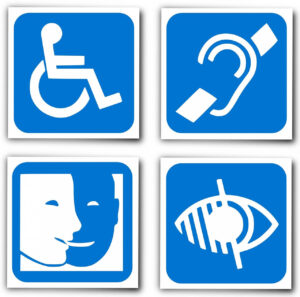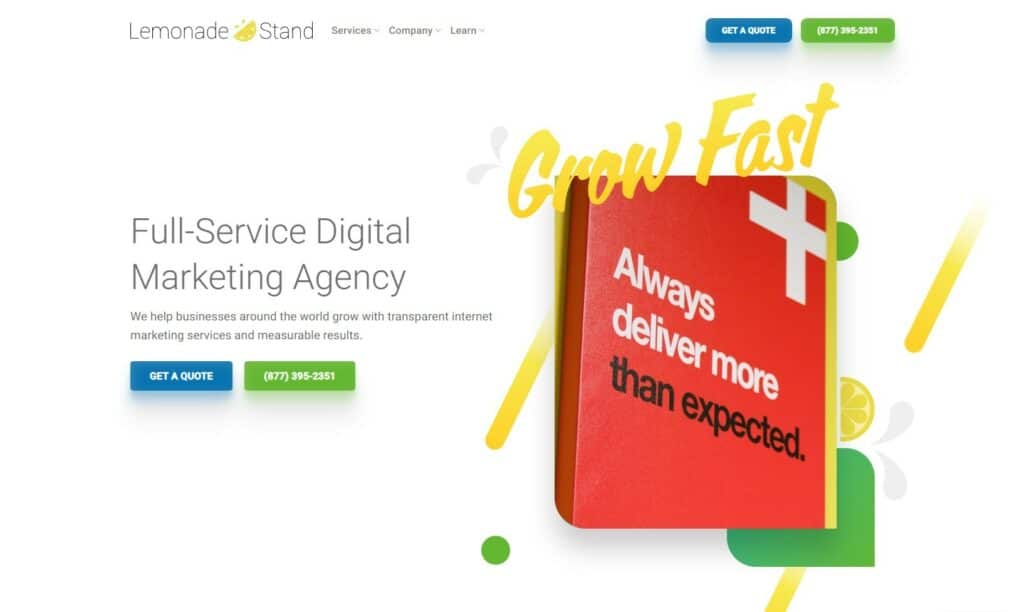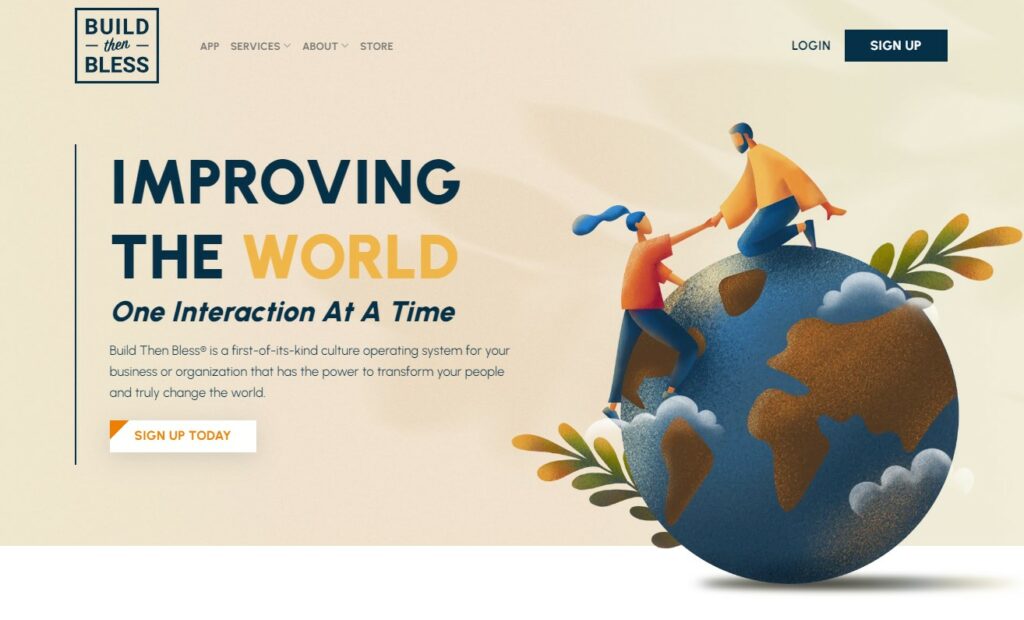Websites need to include policies, statements and disclaimers to keep their companies out of legal hot water. This goes for ADA-compliant web accessibility as well as privacy, legal stuff, terms and conditions, etc.
This particular article is specific to U.S. laws (sorry international friends) regarding web accessibility and how to quickly produce the required verbiage needed for company websites.
Before we delve into the how-to, we need to make sure we all understand how accessibility statements and policies differ.
It’s no secret that when it comes to legal stuff, people often feel a bit of overwhelm tinged with a tad of terror.
It’s okay. We are here to walk you through it. Follow me.

What’s the difference between an Accessibility Statement and an Accessibility Policy?
Accessibility Statements need to be on your website to inform visitors of the accessibility standard you follow and to offer a way for users to provide feedback.
No need to be lengthy…unless you want to. But the statement does need to be there.
And, it’s one place where you need to incorporate one of the Lemonade Stand company values: do what you say and say what you mean.
So if you state that you adhere to the WCAG 2.1 AAA level for accessibility, be sure that you do indeed adhere to ALL of that standard.
If you don’t do what you say, users will catch it and let you know where you come up short. (Cross your fingers that they are civil about it too.)
Incidentally, WCAG stands for Web Content Accessibility Guidelines. It is the generally accepted standard and has gone through a few updates since its creation.
Learn more about the WCAG Standards on the W3C Web Accessibility Initiative website.
Related: Get a high level overview of the difference between WCAG levels A, AA, and AAA.
Accessibility Policy is the set of accessibility rules you set for your organization to follow. This is usually something shared just within your organization, but you can publish it to your users if you wish.
You may opt for a “less-is-more” approach to the small print you put online, like many companies do.
What your Web Accessibility Statement should contain
Statements can range from simple to complex. Simple accessibility statements might be just a few sentences long.
Statements should include at least the following three items:
- Your commitment to accessibility for people with disabilities.
- The accessibility standard applied to your site, such as WCAG 2.1 AA.
- Contact information should a user encounter problems accessing your site.
Here is an example of a simple statement from retailer Swimsuits for All.
FULLBEAUTY Brands is committed to providing a website that is accessible to the widest possible audience, regardless of technology or ability. We aim to comply with all applicable standards, including WCAG 2.0 accessibility standards up to level AA.If you experience any difficulty in accessing any part of this website, please feel free to call us at 800-416-9486 or contact us and we will work with you to provide the information, item, or transaction you seek through an alternate communication method or one that is accessible for you consistent with applicable law (for example, through telephone support).From Swimsuits for All. |
Optional additions that create a more comprehensive statement include:
- Any known limitations, to avoid frustration of your users
- Measures taken by your organization to ensure accessibility
- Technical prerequisites, such as supported web browsers
- Environments in which the content has been tested to work
- References to applicable national or local laws and policies
Here is an example of a more comprehensive statement from accessible.org.
|
SupportDo you need assistance accessing something on our website? Email [email protected] and I will reply as soon as possible.Commitment to AccessibilityAccessible.org is committed to accessibility. It is my (Kris Rivenburgh’s) policy to ensure that persons with disabilities have full and equal access to my digital offerings.FeedbackI welcome any feedback on the performance and accessibility of this website. Email me at [email protected] to provide feedback.StandardsAccessible.org strives to conform to WCAG 2.1 AA standards to ensure digital offerings are fully accessible.CompatibilityAccessible.org is compatible with most major Internet browsers including Chrome, FireFox, and Safari.Accessible.org may not perform optimally on Internet Explorer and older browser versions.CoordinatorAs the sole owner and operator of Accessible.org, I am responsible for all coordinating accessibility efforts. I work with contract developers to improve accessibility.TestingAccessible.org has been manually audited and scanned using automated software (WAVE and AXE ) to ensure accessibility.Training and EducationI have personally taken training administered by Karl Groves of Tenon.io and Jared Smith of WebAIM.org. I have also undergone dozens of hours of informal training and education. Rob Dodson’s YouTube channel has been particularly helpful.ComplianceThrough genuine effort and commitment including manual evaluations, consulting, and remediation, I believe Accessible.org adheres to best practices for compliance with the Americans with Disabilities Act (ADA).ResourcesNVAccess.org offers the NVDA screen reader for free.You can learn more about the right to equal access for all Americans at ADA.gov.Section508.gov provides numerous resources for making accessible websites and maintaining them.W3C and WCAG 2.1 provide technical guidelines and examples for what web accessibility should be.Accessible.org provides web accessibility information and services.From accessible.org. |
How to Write (or Generate) a Web Accessibility Statement
While it should not be difficult to write a simple Accessibility Statement, sometimes it might be more convenient (and help you feel a little more confident) to use the
WAI’s Accessibility Statement Generator.
Plug in a few pieces of information, and it will spit out the text you need for your statement.
So with this little trick, you can quickly don your game face for your website users. Shazam, right?!
If you feel like you need a little more hand holding on this, though, we recommend you download the Accessibility Statement Template from accessible.org.

So, now that you have some great tools for the Accessibility Statement for your website, let’s look at its more complex sibling, the Accessibility Policy.
What Should Be in Your Web Accessibility Policy
The simple answer is whatever you think is appropriate. But that doesn’t give you much direction does it?
One of the most important things about Web Accessibility Policies is that they should be part of your overall planning and strategy from the beginning.
That’s the ideal, anyway.
Hey, we understand that sometimes web accessibility is an afterthought. And that’s okay too.
Wherever you are in your process, we congratulate you for your commitment to web accessibility for all users.
As with accessibility statements, Accessibility Policies range from short-and-sweet to long-and-detailed. They can also be in a stand-alone document and/or be incorporated into other documents, such as equal opportunity policies or anti-discrimination efforts.
No matter where your policy fits in your organization, here are some items you want to consider including.
1. Reference the standard(s) you will meet.
You probably already know about the WCAG standards mentioned earlier. You might even already know which version and level you want to include as part of your policy.
But did you also know there are a couple of other sets of guidelines that may be relevant to your organization? These are the following.
-
- Authoring Tool Accessibility Guidelines (ATAG) – for sites that allow users to generate content, such as: forum postings, uploading images or videos, etc.
- User Agent Accessibility Guidelines (UAAG) – for sites that utilize plugins, add ons and custom controls to deliver content, such as media players and the like.
2. Define the conformance level you will meet.
This is the part where you specify whether you intend to meet level A, AA, or AAA of the WCAG standards.
3. State the scope of your policy.
This means you want to clearly define the parts of your digital assets that are to be included in your compliance efforts.
For example, your scope could include things like:
-
- Websites
- Web tools
- Apps
- Intranets
- Emails
- Text messages
4. Specify your milestones for reaching compliance.
This is where you put some teeth into your compliance goals. State the date by which your site will adhere to the standard level you selected.
In some cases, a phased approach will be appropriate. You can outline how and when issues will be identified, prioritized, and fixed.
In other cases, you may have already achieved the level you were after. In that case, it is appropriate to define when it was accomplished and when/how the site will be reviewed/audited moving forward.
5. Consider third-party content.
If your site includes features or services that you purchase, subscribe to, or syndicate from an outside company, you will want to think about (and specify) how you will handle these third-party pieces.
Common third-party elements include credit card payment systems, mapping services, streaming content, and the like.
Naturally, you cannot control what the third-party vendor does. But you can commit to informing these valuable partners of your accessibility commitment. Some companies choose to exclude vendors not meeting their same compliance level. Again, it is up to you what to do here.
6. Define your monitoring and review process.
Wouldn’t it be great if you could just do the compliance work once and have it last forever?
With the pace technology evolves — for the general public and for those with disabilities — it is necessary to regularly monitor your website for concerns and routinely audit your site for ADA compliance.
So in addition to specifying when you want your digital assets to be audited, you will also want to describe how and/or who will be responsible for carrying out this important work.
While these six items may not seem like for your company’s Accessibility Policy, it’s apparent that it may take a little more thought to define just what you want your policy to include.
How to Write a Web Accessibility Policy
To write your own Web Accessibility Policy, let’s first look at an example.
Honestly, finding such policies is tough since they are usually internal documents that are not shared with the public.
That said, you can see quite a thorough policy online at www.essentialaccessibility.com, where they practice what they preach.
Essential Accessibility’s Web Accessibility Policy
Okay – so I just threw you into the deep end. Did you think you might drown?
Their policy is pretty comprehensive, but you don’t need to feel like you have to do exactly what they did.
Remember, it is up to you what and how much to include in your accessibility policy.
Find examples of brief accessibility policies on the W3C website.
Follow this Template for Writing a Web Accessibility Policy
If there is an easy way to get the Accessibility Policy written correctly, wouldn’t you want to do that? I’ve got you, friend.
W3C delivers again. Instead of a policy generator, they offer an
Accessibility Policy Template.
This standard-setting authority provides the framework and foundation text. You replace the highlighted pieces with your own policy details.
How easy is that?!
When it comes to web accessibility, you want to be sure to get it right and communicate it properly to your customers and users.
We hope that the tips provided here will get you started with solid web accessibility statements and policies.
If you need help or are ready to outsource web accessibility tasks, Lemonade Stand is ready to help with expertise and staff.
With our transparency policies, practices, and tools, you will always know what we are doing and how your budget is being used.
Contact us when you are ready to level up your web accessibility.


